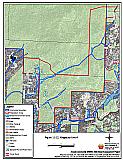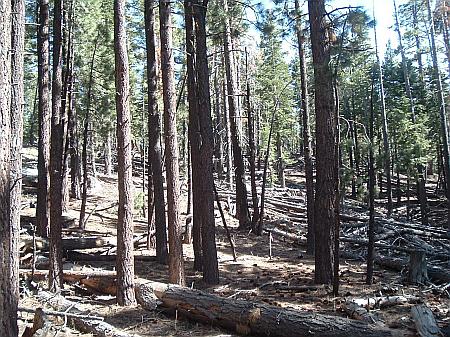Risk/Hazard Identification and Mitigation Project Worksheet
Name of Community: Kingsbury
Date: July, 2004
Project Title: Kingsbury Unit 4 - Thinning and Brush Removal
Description of Risk/Hazard: Describe in detail the risk or hazard that poses a threat to the community.
Vegetative Fuel and Topography: The Kingsbury Unit 4 prescription area is characterized by a second growth stand of Jeffery pine with white fir, sugar pine, and incense cedar below 7,000 feet. Above 7,000 feet, white fir and red fir dominate the stand, especially on north slopes. Brush covers open areas and is an understory (ladder fuel) component in most of the area. The stocking level of trees ranges from 40 square feet of basal area per acre to 400 square feet of basal area per acre with an average of 200 square feet of basal area per acre. Some areas have large accumulations of dead and down fuels, exceeding 80 tons per acre.
Worst Case Scenario / Hazard: The entire treatment area is below the residential and commercial properties at the top of the ridge at Kingsbury. A wind driven fire up any of those drainages would be uncontrollable and likely destroy properties at the top of Kingsbury. The Gondola Fire (2003) exhibited this behavior.
Priority Ranking: What is the priority ranking of this risk/hazard in relation to all others identified?
Because of large expanses of fuels below and upwind of the community, this project ranks as #3 priority for the TDFPD.
Location: Describe or attach a map with sufficient detail to allow accurate ground location.
West side of the ridge at the top of Kingsbury. See Figure 11-12 for details
Recommended Mitigation Measures and Scope of Work: Present prescription and work specifications in sufficient detail to facilitate procurement of bids and quotes. For hazardous fuel removal projects include estimated volumes (tons/acre) of fuel removed and disposal plan.
Given slopes and topography, the treatment in this area must be aggressive to be effective. The area will have to have sufficient treatment to control a direct flame front under extreme fire conditions.
Remove or thin brush understory to lower fire intensity and reduce ladder fuels. Remove dead and down material. Spacing between remaining bushes should be 2-3 times the height of brush and in open areas near trees at least two times the height of the trees. Remove 50% of existing brush in open areas to break up the continuity of brush fields. Remove brush and smaller trees from underneath residual trees and to a distance of 10 feet from the crown of the tree. A brush masticator or “Bull Hog” could be used where slopes are less than 30%. Aerial systems or other steep slope methods should be explored on area greater than 30%. Grind the brush and leave as mulch, or hand cut, pile, and burn. Use of herbicide could reduce sprouting of some species.
Thin forest stand from below, removing smaller trees and leaving larger ones to achieve the desired stocking rate of 80 to 100 square feet of basal area per acre. Where dominant trees are left, prune limbs to 15 feet above the ground and maintain a minimum tree spacing of 10 to 20 feet between crowns. Remove trees heavily infected with dwarf mistletoe or other disease.
*Prescribed fire could be used to reduce the brush understory, and desired where feasible to return fire to the landscape. It should only be applied in areas after thinning and slash pile burning are complete to maintain fire control.
Evaluation of the Extent to Which Completion of This Project Will Reduce the Fire Threat:
Treatment in this area will help contain human-caused ignitions below the project area, keeping fire from spreading uphill towards a residential development and becoming uncontrollable. This treatment will be the best defense against a fire in the lower Kingsbury neighborhoods moving into the upper neighborhoods. This treatment will be necessary for suppression resources to be effective in stopping such a fire. Implementation of the prescription will reduce the competition among residual trees, increasing forest health and decreasing tree mortality. This will reduce the amount of accumulated dead and down material contributing to the fuel loadings on the forest floor. Thinning will also increase the spacing between residual trees, allowing heat from a ground fire to escape through the canopy, lowering fire intensity and decreasing the ability of the stand to carry a crown fire.
If all of the recommendations in this report are implemented, there is still no guarantee that a devastating wildfire will not occur in the area. However, community awareness and individual attention to fuels management on private property and fuel reduction on state, federal, and county property will help to achieve the highest level of wildfire safety possible.
Identification of Protected Species or Other Critical Resources: Describe any measures that must be taken to protect critical wildlife habitat, historic
Area will require a cultural clearance and survey for threatened and endangered species. If there are any protected raptor nest sites then operations may need to be delayed until August - September. This would reduce the amount of time available each year to conduct operations. Known cultural sites should be flagged and mechanized equipment excluded from operation on these sites. Thinning can be achieved by hand or by aerial systems where needed. Closed roads may need permission for temporary opening for treatments.
Environmental compliance measures must be implemented before project initiation. Stream Environment Zones are located in the project area and must be protected, employing appropriate TRPA mitigation measures.
Some threatened and endangered species exist in the Tahoe Basin. Appropriate avoidance and mitigation measures should be employed during project implementation.
Compliance with cultural resource protection may also be necessary. Check with TRPA and the NVSHPO to ensure cultural resources are protected.
Post-project Rehabilitation: Present scope of work in sufficient detail to facilitate procurement of bids and quotes.
Rehabilitate any fire control lines, landings or disturbed areas. Rehabilitation will be minimal if only hand methods are used. Where soil has been disturbed, TRPA rehabilitation measures and Best Management Practices would apply. This could include reseeding or mulching areas if necessary.
Estimated Timeline:
Desirable time of year to complete:
Late fall
Estimated time required to complete project:
Two years if the operating season is cut short to protect raptor nesting sites.
Estimated Cost: Present an estimate of the total cost of project completion and the basis for the estimate presented. If the project can be subdivided into phases or various components, present an estimated cost for each.
Cable yarding is recommended, however, no costs for cable yarding were available. The costs below are a minimum based on currently accepted methods in the Tahoe Basin.
| Hand cut, pile, and burn | $2,000 / acre X 541 acres | |
| Prescribed fire within 5 years | $2,000 / acre X 541 acres | |
| Total Cost | $ 2,164,000 |
Biomass to be removed is approximately 44 tons per acre.
Project Maintenance Requirements:
Project area could be maintained through the use of prescribed fire.
Other Considerations: Describe any other considerations that must be taken into account to successfully complete this project such as permits, clearances, approvals, etc.
- Cultural and T&E clearance (USFS)
- Air Quality Permit
- TRPA approval
- SEZ clearance
- USFS Regional office approval
Figure 11-12Proposed Prescription Area Kingsbury Unit 4 |
 |

